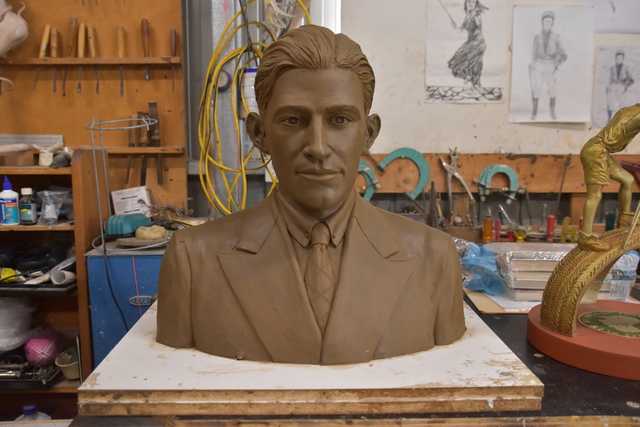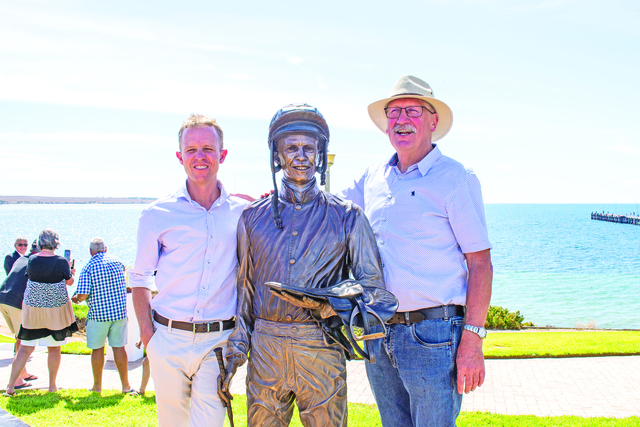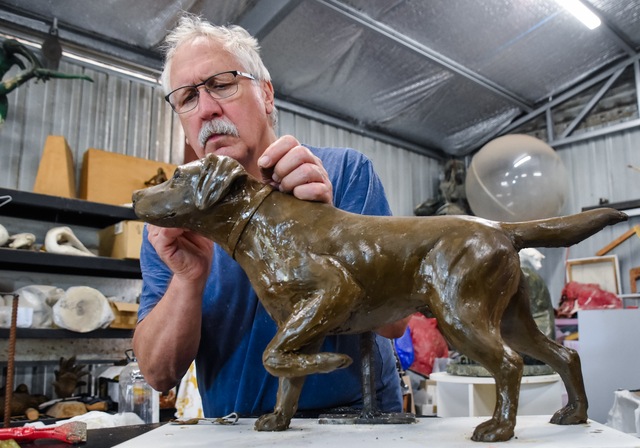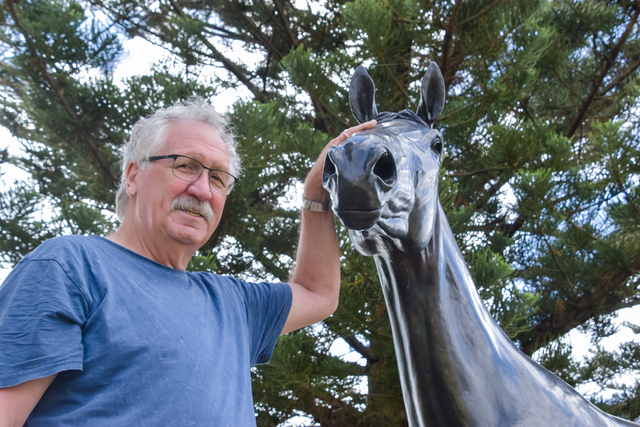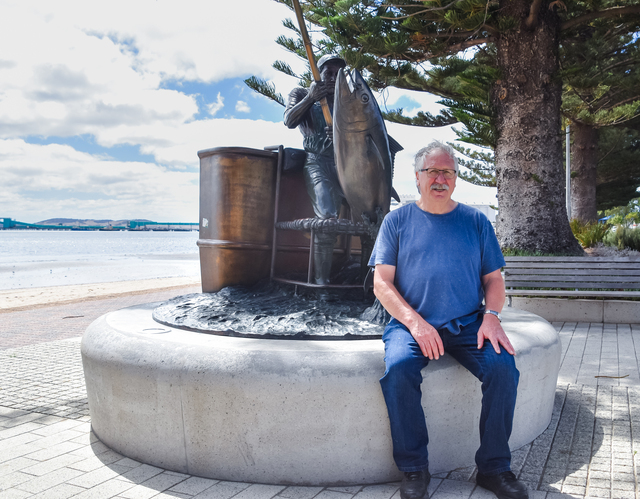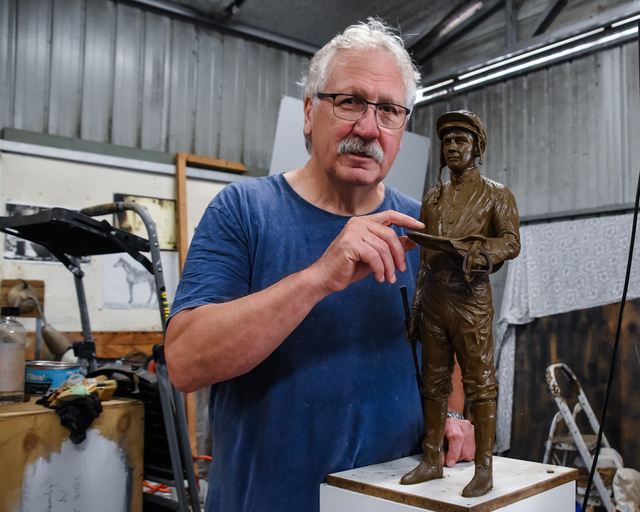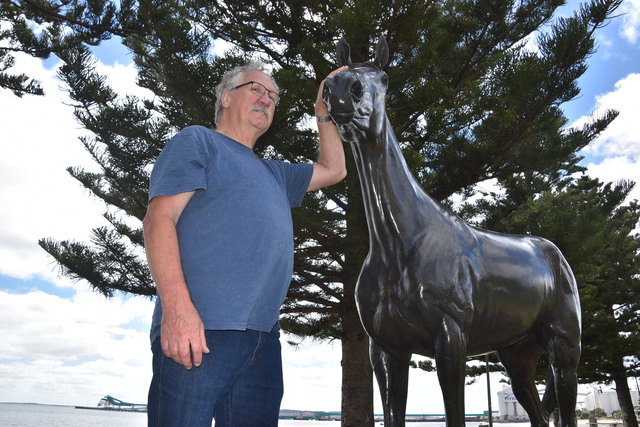
Eminent Port Lincoln sculptor Ken Martin has made his name creating some of Eyre Peninsula’s – and South Australia’s – most iconic bronze statues.
Along a stretch of the idyllic Port Lincoln foreshore adorned in bronze, glistening in the sunshine breaking between the trees are two recognisable figures for the city’s residents.
In their own way, they helped to put Port Lincoln on the map.
Makybe Diva is a three-time Melbourne Cup winning horse with a connection to Port Lincoln – a city which exceeds expectations in the sporting arena – through tuna fisherman owner Tony Santic.
The city adopted her as its own, even though she had never physically been there, and Port Lincoln received great notoriety from Makybe Diva’s successes.
And to see the figure of the Tuna Poler is to see the history of ‘Seafood Capital’ Port Lincoln itself.
They are tourist attractions, with visitors eager to snap a photo of the bronze foreshore figures.
The two statues are the work of renowned local sculptor Ken Martin.
At Ken’s home workshop, you get a glimpse into the hours spent on his compositions, the stunning figures he has brought to life.
Dotted around the workshop are maquettes of past and present works. Some are instantly recognisable as his public works, including Kerrin McEvoy. Others are projects of private commissions.
Ken spends hours here, often working on multiple projects at once.
“I grew up with the idea to focus on one piece at a time, but the reality is with sculpture I find it is good to work on up to three pieces at once,” he said.
“If you work on one piece for a long time you can start to tread water and fiddle.
“If you shift your mind and come back with fresh eyes, you can come back more clearly.”
One piece can take a long time. Ken estimated he would spend 100 hours or more working on a maquette – the miniature piece created with plasticine that resolves the concept design before sculpting the larger work.
It can take eight to 12 months from the initial design phase to the finished product, including the maquette, design process, sculpt of master, moulding and casting.
When you account for the many decades Ken has been sculpting and creating, it is a lifetime of passion, dedication and constant improvement to his craft.
That is why Ken’s works are highly sought after, not only in his home town, but elsewhere.
Visit Adelaide Oval and you will find four of Ken’s captivating life-size bronze sculptures of iconic SA sportsmen greeting fans as they head inside – Barrie Robran, Ken Farmer, Darren Lehmann and Jason Gillespie.
Closer to home, Ken worked with three-time Melbourne Cup winning jockey Kerrin McEvoy and the Streaky Bay community, which fundraised to commission a bronze statue of its champion on the foreshore that was unveiled in 2022.
There are about a dozen of Ken’s statues across SA, but some are even further afield.
“It is a privilege, and I have been fortunate – if you include wood – to have pieces in eight countries,” Ken said.
“It feels good, but I don’t get too caught up in that; there is always something to learn and I enjoy what I do.”
For how highly regarded the sculptor is and how sought-after his bronze works have become, it is somewhat surprising to learn the Makybe Diva statue, unveiled in 2006, was Ken’s first public bronze piece.
“Bronze is now my first choice, but for a good 25 years, wood was my medium for sculpture,” Ken said.
It was wood that led Ken to Port Lincoln in the first place.
He grew up moving from town to town, initially in the South East but then to various locations across South Australia.
Ken’s father was a mobile shearer and he, for a time, took that up.
But Ken sought a different path and left school – he had been to eight of them – and home at the age of 14.
Twelve years later, in 1978, he arrived in Port Lincoln as one of the original partners of Constantia Furniture.
Ken had no art school background. He simply had a passion for drawing, which expanded to other pursuits as he got older.
“In my early 20s I found 3D work. I was working in Naracoorte and had access to Mount Gambier stone and wood, and I started experimenting with 3D wood and stone sculpture,” he recalled.
“When I met the other men to form the partnership to come to Port Lincoln I was going into wood carving.
“That was my first professional foray into arts and a lot of sculptures were produced in those eight years.”
Ken noted he enjoyed working in 3D.
“I love the idea of capturing the essence of a person, an animal, or situation, in 3D,” he said.
“I had no formal education, but reading through books I was fascinated with past works.”
And some of Ken’s influences are the best ever.
Names like Michelangelo and Bernini have inspired, so too Auguste Rodin.
“The ancient Greek sculptors were marvellous, and then the Italian Renaissance period was remarkable,” he claimed.
“I remember going through the museum at the Sistine Chapel and seeing the statue of Laocoön and His Sons – I was so taken by the energy of the piece.”
In wood, Thomas Chippendale and Grinling Gibbons were also inspirations, with their fluidity and ability to “bring wood to life”.
“It transcended the slight stiffness of earlier carving.”
In the mid-1990s Ken started working with clay for the purpose of casting to bronze and said he enjoyed the process.
That started his love affair with metal.
“All mediums have their challenges and it took a while to make the transitions as the mediums are different, but I enjoy it.”
Along with learning to work with bronze was another aspect – dealing with foundries and the need to procure the metal.
He is involved with the process from design and maquette through to the final casting of bronze – the finished products are hollow.
Ken explained that in order to get to the finished state there is initially a silicon rubber mould, with sections then recreated in wax.
The wax is refined and invested into a plaster mould and burnt out for the metal to be poured in.
“There are a number of processes where things can go wrong, but it is rare,” he said.
In order to check up on the various stages of production, the 72-year-old is a frequent visitor to the foundry in Melbourne he works with.
“There are two main stages when my presence is required – when wax is cast prior to moulds and then checking on seam lines to see if they are correct before being invested and burnt out,” he said.
“Then at the final stage I make sure all sections are brought together correctly.”
The mould is taken in Port Lincoln, then sent to Melbourne.
Asked which of his finished products was his favourite, Ken likened it to choosing your favourite child, but had an affinity for Makybe Diva.
“It will always have a special place for me as it was my first major public work and a huge challenge,” he stated.
“This was the most famous horse in the world at the time and it had to be right.
“I also look at the Tuna Poler and Kerrin, and I’m delighted to have both pieces on Eyre Peninsula.”
Ken has pieces on the go all the time, at various stages of production.
A planned life-size piece of Formula 1 legend Ayrton Senna hit a brick wall because the person behind the project was involved in a serious motorcycle accident.
The maquette has received approval from the Senna family and should it go ahead, is planned to be installed somewhere along the Adelaide Street Circuit Senna triumphed at twice.
A private piece he is working on is a life-size osprey lifting a fish out of the water.
“It is a complex piece creatively, it has to be anatomically correct and it took time to understand the biology – to do so I had the aid of the local osprey society and a biologist,” Ken said.
While not currently working on any public Eyre Peninsula pieces, Ken is imparting his wisdom on the region’s next generation of artists.
St Joseph’s School student Henri Jenkins is a pupil of the sculptor and a regular visitor to the workshop.
“Henri is so driven that I couldn’t refuse his approaches,” Ken laughed.
“I am hoping to impart some of the technical aspects and the realities in making a living in sculpture.”
If you are passionate about art, Ken said, then give it a go.
It was that passion which drove him forward decades ago.
“I’ve been told plenty of times it wouldn’t work, but I refused that as I needed to make it work – there is nothing like that drive to help you press on,” Ken remarked.
“I was very fortunate to meet and marry the girl I did, back in 1977, the daughter of an Italian immigrant, Elisa; she bought my first carving chisels.
“Her family saw creative work as a realistic option going forward and that was foreign to me. That encouragement was important to me when starting.”
Ken is at home working in Port Lincoln, in a region he said “punches above its weight when it comes to creativity”.
“I think it is a place that has always had creativity, even going back to the farmers and fishers and those involved, who had to solve problems to make things work,” he said.
“Isolation is another thing that contributes to that. There are some things even today we can’t take for granted that maybe they do in the city, so we find ways around it.
“Creativity across the board attracts me. I love the relaxed culture and ability to go in the bush and marine environment – I have to do that every so often for my sanity!”
As we head to the foreshore to take pictures with Ken’s two famous works for this article, along comes a couple from Brisbane taking photos of the Tuna Poler.
Standing alongside them, it was decided to introduce Ken to the couple – now they could not only snap a photo with the statue, but with the sculptor himself.
The grateful couple, smiling, went off to see Makybe Diva and continue their stroll through Port Lincoln.
Such is the reverence for Ken’s statues.

